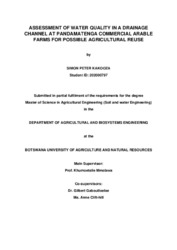| dc.description.abstract | Botswana is a semi-arid country with low rainfall and a lack of water resources. The country has reached its full potential in terms of surface water development, that is, the construction of dams, owing to the flat topography in most parts of the country. With an economy in transition, Botswana needs water for economic growth in the areas of households, energy, agriculture, tourism, manufacturing and mining. Agricultural Drainage Water (ADW) reuse is therefore an ideal alternative. This research, therefore, was set out to assess the quality of water in the drainage channel located in the northern plain of the Pandamatenga Commercial Arable farms for possible agricultural reuse. This was achieved by analysing physical parameters (pH, TDS, EC), microbiological parameters (E. coli, Faecal coliform, total coliforms) and chemical parameters (Ca2+, Pb2+, Na+ , NO3, Cl‾, SO4 -2 , Fe2+, Mn2+, Cu2+, Mg2+, HCO3‾) of sampled runoff along the drainage channel and comparing it to the BOS 463:2011 – Water quality for Irrigation standard and Wastewater quality standard BOS 93:2012. The results obtained from the ADW quality analysis were then used in an Irrigation Water Quality Index (IWQI) model to assess the possibility of reusing the agricultural drainage water. The results of the study revealed that almost all ADW quality parameters were below the permissible limit as per BOS 463: 2011 and BOS 93: 2012 standards. However, high levels of Total coliforms, E. coli and faecal coliforms were registered in most of the water samples. The IWQI values computed from the five parameters of SAR, EC, sodium, chloride and bicarbonate during the study revealed that 95% of the samples fell within the “severe restriction” category, 5% of the samples fell under the “moderate restriction” and no samples belonged to the “no restriction” category. Although 84% of the analysed ADW passes the quality mark of the wastewater and irrigation standards, the low levels of EC and SAR detected during the study period imply that there is a mineral imbalance, thus making the ADW unsuitable for direct reuse. Additionally, the high levels of microbiological parameters indicate that irrigating “ready-to-eat” crops with such water increases the risk of food borne illness. Therefore, using this ADW will require mixing it in proper ratios with pure water to improve its quality for reusability during irrigation or using the ADW with trickle or drip irrigation systems since they present a lower risk for potential contamination of crops as compared to an overhead spray system. | en_US |

